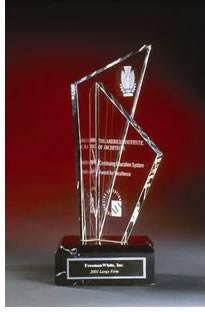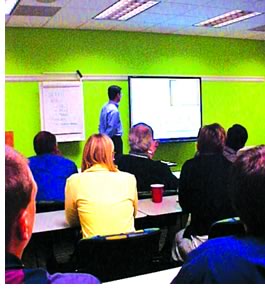
by Alan T. Baldwin, AIA
President, FreemanWhite
 In
1992, our firm undertook a comprehensive strategic planning process that
resulted in an entirely new business direction for FreemanWhite. We decided
to work "narrow and deep" by focusing on three markets: health-care,
government, and senior living. We also augmented our traditional architectural-design
heritage by undertaking to offer strategy and operational-analysis consulting
services as well. The result is a multidiscipline firm dedicated to our
clients' overall business success.
In
1992, our firm undertook a comprehensive strategic planning process that
resulted in an entirely new business direction for FreemanWhite. We decided
to work "narrow and deep" by focusing on three markets: health-care,
government, and senior living. We also augmented our traditional architectural-design
heritage by undertaking to offer strategy and operational-analysis consulting
services as well. The result is a multidiscipline firm dedicated to our
clients' overall business success.
The resulting need for strong and carefully focused growth—to give the firm the increased market depth and breadth of services—meant bringing in or developing in-house a wider variety of skill sets. It was clear that a formalized education system would be necessary to facilitate growth and business strength across the diverse spectrum of services we set out to master.
 Setting
educational goals
Setting
educational goals
FreemanWhite's leadership determined to incorporate educational initiatives
within each of the six strategic goals we had set for the firm's growth.
For the firm to establish itself as a leader, we realized, every individual
needed to grow as well. We organized the company's education program under
the rubric of the FreemanWhite Academy.
The five education goals for the academy are to:
• Provide continuous learning throughout the employee's career
• Provide employees with the knowledge and skills to meet individual
job performance expectations and professional continuing education requirements
• Provide knowledge interconnectivity across the firm's strategic
goals, systems, and culture; the three markets; and three service disciplines
• Provide flexibility in subject matter and delivery methods
• Strengthen the profession by offering continuing education courses
to fellow practitioners.
The managing principals formulated these overall and long-term goals based on specific growth projections and the skills we needed to achieve a high level of professional expertise. The FreemanWhite Academy was, in turn, structured to provide those skills. Currently, it provides more than 130 courses supporting more than 230 employees in 42 different staff positions.
An ever-sharpening
curriculum
As an example, the academy has developed 15 core classes for the firm's
project managers, with each providing the information necessary for maintaining
licensure and professional-association membership and imbuing knowledge
of the firm's culture, systems, and processes. Those core classes cover
negotiating contracts and fees; managing project scope; negotiating consulting
contracts and fees; client development and maintenance; consultant contracts,
coordination, and management; risk for managers; business office/project
manager interface; quality management; production process; project and
quality management refresher; FreemanWhite schedules; leadership; team
building; public speaking; risk management/legal; and project process
development.
The overall curriculum of the FreemanWhite Academy reflects the needs of the firm's entire hierarchy, from interns undertaking IDP to firm principals sharpening up team-building and presentation skills. We identified the original core curriculum through focus groups across a variety of architectural positions. Since the beginning, suggestions from staff have driven ongoing refinement in curriculum and instructors. After completing a class, an employee evaluates it online by way of a form sent to that employee via email. These forms are returned to the training coordinator and human resources. The data are collected and analyzed, and the summary evaluations of all classes are reviewed regularly by the program coordinators and management. If irregularities arise (either great suggestions or extremely negative complaints) they are immediately addressed. A survey of the academy goes out to all staff each year via email to evaluate educational needs. The FreemanWhite intranet also includes an anonymous suggestion forum to provide another feedback outlet. This staff feedback keeps the academy attuned to changes in the professional arena, the markets we serve, and technological advancements.
 The
architect has many ways to assess and continue the development of the
firm's education program. New learning from sources outside the firm,
such as professional or trade associations, experts in specialized fields,
or cutting-edge technologies all provide opportunities for new courses.
Learning is a priority to the firm and its employees, so any number of
knowledge sources can be suggested and included in the academy's curriculum
or offered as a special one-time course.
The
architect has many ways to assess and continue the development of the
firm's education program. New learning from sources outside the firm,
such as professional or trade associations, experts in specialized fields,
or cutting-edge technologies all provide opportunities for new courses.
Learning is a priority to the firm and its employees, so any number of
knowledge sources can be suggested and included in the academy's curriculum
or offered as a special one-time course.
Performance projections
One of the firm's strategic goals is to measure results so we can document
the value we create. As we do with all of our work, we apply that goal
to the FreemanWhite Academy—ranging from organizational results to
projections for individual employees.
Long-term firm measurements include revenues, staff size, and employee turnover. Over the past three years, revenue growth has averaged 27 percent, staff growth has increased by 25 percent, and turnover currently rests at 8 percent.
Client measurements include errors/omissions and projects on budget percentages. Currently, the firm's errors/omissions rate stands at less than 1 percent (the industry standard is 2 percent or more) and the estimated cost of projects versus actual cost rests at plus or minus 4 percent (the industry standard is plus or minus 8 percent).
We measure individual performance by the number of licenses and professional-association memberships renewed as well as participation in the FreemanWhite Academy and the stipend program (whereby FreemanWhite provides a set amount of money per employee, based on their position in the firm, for self-directed education and training). Our professionals hold 331 licenses in 38 U.S. states, and our employees have memberships in 55 different associations. Participation in the academy courses averages well beyond the required number of courses, and the stipend program has virtually 100 percent participation.
By setting up a structured and staffed academy for learning within FreemanWhite, we have demonstrated to everyone here that learning and personal and professional development are part of this firm's culture. Our first strategic goal is to live, breathe, and deliver to the client the "FreemanWhite experience." Through innovative solutions and measurable results, we have succeeded in strengthening our credibility as one of the select few firms in clients' eyes. Through staff development we continue to improve our levels of efficiency, quality, and speed to market by maintaining our focused market approach and depth of ability.
Copyright 2002 The American Institute of Architects. All rights reserved.
![]()
|
FreemanWhite, the 11th oldest architecture firm in the country, founded in 1892, has offices in Charlotte; Raleigh, N.C.; and Minneapolis. For more information about FreemanWhite Academy, visit the firm's Web site or contact Jill Brown. For more information about the AIA/CES Awards for Excellence contact the AIA |
|